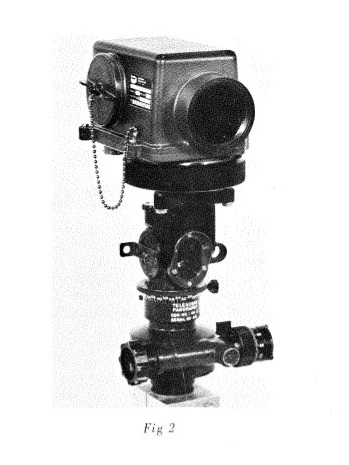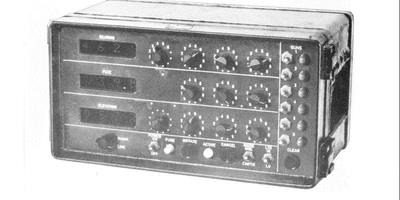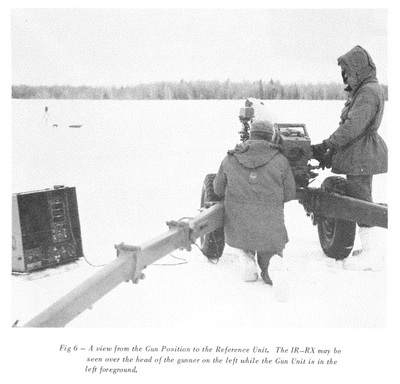Equipment News - The Gun Alignment and Control System
Major C.A. Moogk
During the months of September and October 1972, La Batterie X augmented by the rest of 5e RALC conducted the L5 portion of the Canadian forces Trial of the Gun Alignment and Control System (GACS). Without pre-empting the Trial Officer’s report it is felt that our readers may be interested in some of the features of this system which may well become part of the Gunner’s tool kit in the near future. Apologies are offered in advance to our TSO’s and other space –age brothers for a lack of technical detail. This article is only intended to convey a “Mud gunner’s” view of the system. The GACS is described as “A radically new fire control equipment for towed or self-propelled artillery which orients all guns on the gun position within seconds and provides an error free numerical display of bearing, fuze and elevation at each weapon”. An important misconception, engendered perhaps by this definition, needs to be dispelled here. The GACS system only passes data to the gun. Application is by normal manual methods. This is however a step towards the automation of surface-to-surface artillery.
Let us first examine the GACS components and then see how they are used in operation.
The GACS Reference Unit (RU) (figure 1) is set up on a tripod in the same position as the Aiming Circle and performs a similar function. The RU is oriented on grid north using any of the normal methods (gyro, parallel line, RO bearing or compass).
The RU itself consists of two major components: a narrow laser beam which rotates once per second and an omnidirectional Xenon Flash tube. Each time the laser beam passes through grid south the flash tube emits a pulse of infra-red energy in all directions in azimuth.
The Infra-Red Receiver (figure 2) is mounted above the panoramic telescope of the gun. It receives both the IR pulse and the laser radiation from the RU.
The Gun Unit (GU) (figure 3) is located with the gun and is capable of displaying a reference angle from the RU, a target bearing from the CP or the sum of both of these. It displays these angles in the “Bearing” window. It also displays the fuze and elevation as received from the CP by line or radio (AN/PRC 25).
The Command Post Unit (CPU) (figure 4) is used to transmit bearing, fuze and elevation to the gun. It can be set manually or linked to a gun data computer. Common data can be sent to a fire unit or individual data can be sent to each gun.
Now let us see how all this functions during the occupation of the gun position. The RU is set up and oriented during the recce of the position. The gun arrives at its platform and its IR receives an IR pulse once per second as the laser beam passes grid south during its rotation. The GU then essentially counts the time interval between the receipt of the Xenon pulse and the moment the laser beam sweeps past it. This time interval is converted to an angle by the GU, added to the bearing centre of arc as received from the CPU and displayed in the “Bearing” window. The combined angle is now applied to the main scale and the gun is laid in the normal manner. Bearing data during a fire mission is applied in a similar way. Fuze and elevation are received directly from the CPU and displayed by the GU. Figure five shows the GU, RU and IR receivers.
Several advantages of this system are:
FIRST. The gun receives an initial angle for orientation within one second of being ready for this angle. There is no waiting for the GPO to do sums at the aiming circle. In fact no one need be at the RU during occupation.
SECOND. All guns receive their angle during occupation as soon as they are ready for it. It is thought that a self-propelled unit might remain in a hide up to the fire mission and drive onto the gun position for the mission only. Orientation would be almost instantaneous. Speed into action thus enhanced.
THIRD. The GACS automatically compensates for any movement of the gun from its initial position caused by recoil forces.
FOURTH. It is claimed that the system will reduce the incidence of human error in the gunnery system. This need may be scoffed at by peacetime gunners of today but may well have an advantage in operations of war with a reduced level of training and an increased “twitch factor”.
FIFTH. The system is another step toward the automation of surface-to-surface artillery. The GACS system augmented by servo-mechanisms at the gun may well reduce the man-power bill of our regiments.
The trials started with one week of familiarization. For the first while, all ranks gawked in awe at the mysterious spaceage machinery but quickly overcame their hesitation and fervently worked at becoming as familiar with the new equipment as with the old. Familiarization was followed by five weeks of all types of gunnery exercises. There were seemingly endless live and dry deployments both as a two-troop battery and as a six-gun fire unit using both GACS and the “old” director orientation method. A three-day exercise was incorporated into the trials which involved several night deployments and night firing. All types of missions were fired including several with that ever-so-rare commodity, the illuminating projectile. Has anyone ever seen a 2500 meter linear illumination shoot? A day of quick actions rounded off the trials.
X Battery with its bolstered ranks worked hard during the trials and fared well in spite of many obstacles. There were people in the composite battery who had never worked together before, and people who were forced into unfamiliar jobs due to a shortage of manpower; there were innumerable vehicle and equipment problems and the GACS equipment was strange, heavy and bulky. Yet, the old gunner flexibility came through and the group soon developed into a functional team.
The trial team wanted a user trial and they got it. They received feedback on every conceivable aspect of the GACS. The “tin goose” was kicked around like any other piece of kit. Endless readings were compiled. In short, the equipment was used by an operational battery and the results recorded.
The GACS trial team moved to Gagetown in mid-October to continue the user trials with E Bty and their M109s. Though members of X Bty have their impressions and ideas on the advantages and disadvantages of the equipment, it is considered more appropriate to await the trial officer’s final report rather than to draw premature conclusions at this stage.
The Canadian Gunner, 1972, Volume 8, December 1972, page 66
Major C.A. Moogk
During the months of September and October 1972, La Batterie X augmented by the rest of 5e RALC conducted the L5 portion of the Canadian forces Trial of the Gun Alignment and Control System (GACS). Without pre-empting the Trial Officer’s report it is felt that our readers may be interested in some of the features of this system which may well become part of the Gunner’s tool kit in the near future. Apologies are offered in advance to our TSO’s and other space –age brothers for a lack of technical detail. This article is only intended to convey a “Mud gunner’s” view of the system. The GACS is described as “A radically new fire control equipment for towed or self-propelled artillery which orients all guns on the gun position within seconds and provides an error free numerical display of bearing, fuze and elevation at each weapon”. An important misconception, engendered perhaps by this definition, needs to be dispelled here. The GACS system only passes data to the gun. Application is by normal manual methods. This is however a step towards the automation of surface-to-surface artillery.
Let us first examine the GACS components and then see how they are used in operation.
The GACS Reference Unit (RU) (figure 1) is set up on a tripod in the same position as the Aiming Circle and performs a similar function. The RU is oriented on grid north using any of the normal methods (gyro, parallel line, RO bearing or compass).
The RU itself consists of two major components: a narrow laser beam which rotates once per second and an omnidirectional Xenon Flash tube. Each time the laser beam passes through grid south the flash tube emits a pulse of infra-red energy in all directions in azimuth.
The Infra-Red Receiver (figure 2) is mounted above the panoramic telescope of the gun. It receives both the IR pulse and the laser radiation from the RU.
The Gun Unit (GU) (figure 3) is located with the gun and is capable of displaying a reference angle from the RU, a target bearing from the CP or the sum of both of these. It displays these angles in the “Bearing” window. It also displays the fuze and elevation as received from the CP by line or radio (AN/PRC 25).
The Command Post Unit (CPU) (figure 4) is used to transmit bearing, fuze and elevation to the gun. It can be set manually or linked to a gun data computer. Common data can be sent to a fire unit or individual data can be sent to each gun.
Now let us see how all this functions during the occupation of the gun position. The RU is set up and oriented during the recce of the position. The gun arrives at its platform and its IR receives an IR pulse once per second as the laser beam passes grid south during its rotation. The GU then essentially counts the time interval between the receipt of the Xenon pulse and the moment the laser beam sweeps past it. This time interval is converted to an angle by the GU, added to the bearing centre of arc as received from the CPU and displayed in the “Bearing” window. The combined angle is now applied to the main scale and the gun is laid in the normal manner. Bearing data during a fire mission is applied in a similar way. Fuze and elevation are received directly from the CPU and displayed by the GU. Figure five shows the GU, RU and IR receivers.
Several advantages of this system are:
FIRST. The gun receives an initial angle for orientation within one second of being ready for this angle. There is no waiting for the GPO to do sums at the aiming circle. In fact no one need be at the RU during occupation.
SECOND. All guns receive their angle during occupation as soon as they are ready for it. It is thought that a self-propelled unit might remain in a hide up to the fire mission and drive onto the gun position for the mission only. Orientation would be almost instantaneous. Speed into action thus enhanced.
THIRD. The GACS automatically compensates for any movement of the gun from its initial position caused by recoil forces.
FOURTH. It is claimed that the system will reduce the incidence of human error in the gunnery system. This need may be scoffed at by peacetime gunners of today but may well have an advantage in operations of war with a reduced level of training and an increased “twitch factor”.
FIFTH. The system is another step toward the automation of surface-to-surface artillery. The GACS system augmented by servo-mechanisms at the gun may well reduce the man-power bill of our regiments.
The trials started with one week of familiarization. For the first while, all ranks gawked in awe at the mysterious spaceage machinery but quickly overcame their hesitation and fervently worked at becoming as familiar with the new equipment as with the old. Familiarization was followed by five weeks of all types of gunnery exercises. There were seemingly endless live and dry deployments both as a two-troop battery and as a six-gun fire unit using both GACS and the “old” director orientation method. A three-day exercise was incorporated into the trials which involved several night deployments and night firing. All types of missions were fired including several with that ever-so-rare commodity, the illuminating projectile. Has anyone ever seen a 2500 meter linear illumination shoot? A day of quick actions rounded off the trials.
X Battery with its bolstered ranks worked hard during the trials and fared well in spite of many obstacles. There were people in the composite battery who had never worked together before, and people who were forced into unfamiliar jobs due to a shortage of manpower; there were innumerable vehicle and equipment problems and the GACS equipment was strange, heavy and bulky. Yet, the old gunner flexibility came through and the group soon developed into a functional team.
The trial team wanted a user trial and they got it. They received feedback on every conceivable aspect of the GACS. The “tin goose” was kicked around like any other piece of kit. Endless readings were compiled. In short, the equipment was used by an operational battery and the results recorded.
The GACS trial team moved to Gagetown in mid-October to continue the user trials with E Bty and their M109s. Though members of X Bty have their impressions and ideas on the advantages and disadvantages of the equipment, it is considered more appropriate to await the trial officer’s final report rather than to draw premature conclusions at this stage.
The Canadian Gunner, 1972, Volume 8, December 1972, page 66
Bell Centre




